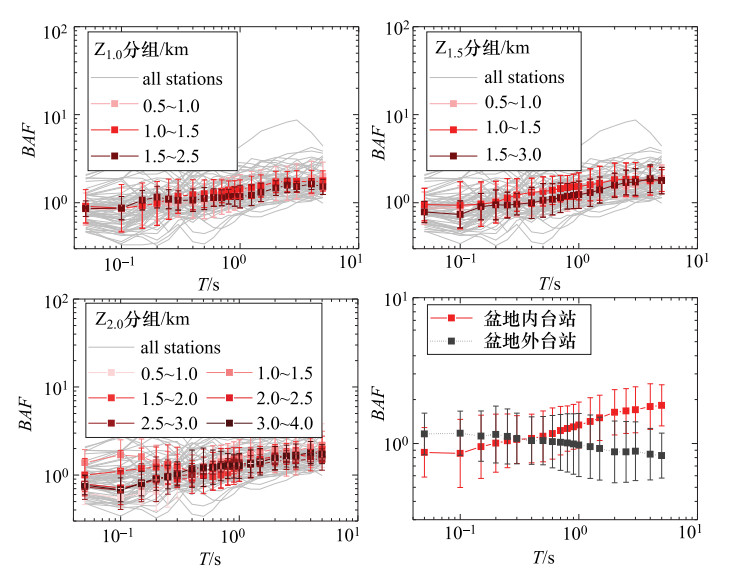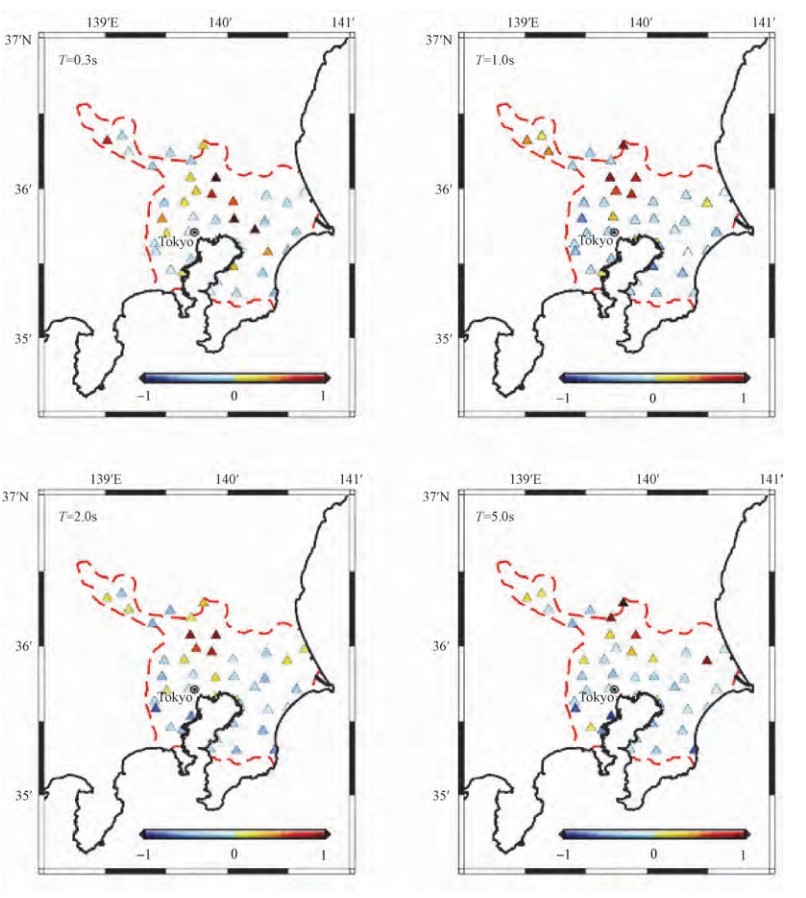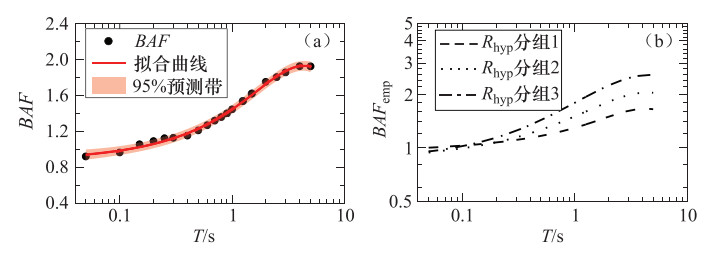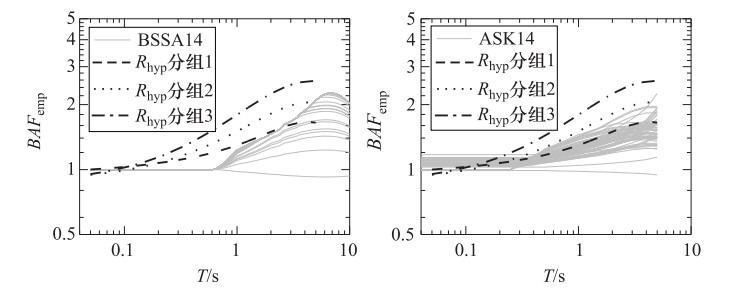Basin Extra Amplification Effects from Seismic Ground-Motion Residual Analysis: A Case Study of Kanto Basin, Japan
-
摘要: 我国地震动预测及地震危险性分析通常仅考虑局部场地浅层岩土层对地震动的放大效应,不能考虑较大范围的地质条件影响,如沉积盆地厚沉积层对地震动的附加放大效应通常被忽略,造成盆地内地震动及地震危险性预测结果普遍被低估。本文以地震动观测记录数据充足的日本关东盆地为例,采用地震动残差分析方法评估盆地附加放大效应,分析覆盖层厚度、盆地内空间位置、震级、震源距对地震动放大效应的影响,建立关东盆地附加放大效应经验评估模型。分析表明:关东盆地附加放大效应与反应谱周期相关,整体上从短周期的1.0逐渐增大至周期为5s时的1.5,附加放大效应与覆盖层厚度相关性较小,主要受盆地空间位置和震源距的影响;盆地北部边缘及西北部地区附加放大效应更强烈,盆地南部附加放大效应较小,这可能与盆地边缘效应密切相关。本文建立的关东盆地附加放大效应经验模型略高于BSSA14和ASK14模型的放大效应预测。相关研究结果可用于我国地震动预测、下一代地震动区划图修订等。Abstract: The ground motion prediction equations of China does not take the basin effects into account, resulting in the apparent underestimations for predicted ground motions and seismic hazards in the basin. The enhanced ground motions due to the thick sedimentary in basin amplifies the earthquake damages on engineering structures located in the basin. To evaluate the extra amplification effects in Kanto Basin, Japan, the residual analysis method of ground motion was applied to calculate the extra amplification effects in Kanto Basin. The factors, including potential influences of sediment thickness, spatial location in the basin, seismic magnitude and hypocentral distance were discussed. The result indicates that, the extra amplification effect is correlated with the spectral period, which gradually increases from 1.0 at short period to 1.5 at spectral period of 5s. The extra amplification effects are independent with the sediment thickness, while dependent on the hypocentral distance and spatial location. The north and northwest margins in the basin experienced much stronger amplification effects, being relatively smaller in the south Kanto Basin. Based on the extra amplifications at these stations, we developed the empirical model applied in the Kanto Basin. Compared with the BSSA14 and ASK14 models of NGA-West2, our model provided stronger predictions. This model could be used to revise Chinese ground motion prediction equations for the next generation of zoning map.
-
Key words:
- Ground motion /
- Residual analysis /
- Kanto basin /
- Basin extra amplification effect /
- Empirical mode
-
表 1 基础经验模型的拟合系数
Table 1. Fitness coefficients of empirical basic model
值 系数 C T1 T2 n1 n2 - 0.08750 1.6209 7.3731 0.7381 1.7743 表 2 震源距调整基础模型的拟合系数
Table 2. Fitness coefficients of adjusted model scaling with hypocentral distance
震源距/km 系数 Di T3i n3i 0<Rhyp≤100 0.3511 0.9702 -0.2742 100<Rhyp≤200 -0.1264 1.5950 0.1258 200<Rhyp≤300 -0.6790 1.3022 0.6643 -
刘启方, 于彦彦, 章旭斌, 2013. 施甸盆地三维地震动研究. 地震工程与工程振动, 33(4): 54-60. http://www.cnki.com.cn/Article/CJFDTotal-DGGC201304007.htm 刘烁宇, 李英民, 2018. 盆地型长周期地震动的判别准则. 湖南大学学报(自然科学版), 45(5): 85-93. http://www.cnki.com.cn/Article/CJFDTotal-HNDX201805010.htm 潘华, 张萌, 李金臣, 2017. 美国地震区划图的发展——地震危险性图与抗震设计图. 震灾防御技术, 12(3): 511-522. http://zzfy.eq-j.cn/zzfyjs/ch/reader/view_abstract.aspx?flag=1&file_no=20170307&journal_id=zzfyjs 王海云, 2011. 渭河盆地中土层场地对地震动的放大作用. 地球物理学报, 54(1): 137-150. doi: 10.3969/j.issn.0001-5733.2011.01.015 张萌, 潘华, 李金臣, 2017. 美国建筑抗震设计的法规体系与设计地震动的确定. 震灾防御技术, 12(2): 306-318. http://zzfy.eq-j.cn/zzfyjs/ch/reader/view_abstract.aspx?flag=1&file_no=20170207&journal_id=zzfyjs Abrahamson N. A., Silva W. J., Kamai R., 2014. Summary of the ASK14 ground motion relation for active crustal regions. Earthquake Spectra, 30(3): 1025-1055. doi: 10.1193/070913EQS198M Atik L. A., Abrahamson N., Bommer J. J., et al., 2010. The variability of ground-motion prediction models and its components. Seismological Research Letters, 81(5): 794-801. doi: 10.1785/gssrl.81.5.794 Boore D. M., Stewart J. P., Seyhan E., et al., 2014. NGA-West2 equations for predicting PGA, PGV, and 5% damped PSA for shallow crustal earthquakes. Earthquake Spectra, 30(3): 1057-1085. doi: 10.1193/070113EQS184M Chandramohan R., Baker J. W., Deierlein G. G., 2016. Quantifying the influence of ground motion duration on structural collapse capacity using spectrally equivalent records. Earthquake Spectra, 32(2): 927-950. doi: 10.1193/122813eqs298mr2 Denolle M. A., Miyake H., Nakagawa S., et al., 2014. Long-period seismic amplification in the Kanto Basin from the ambient seismic field. Geophysical Research Letters, 41(7): 2319-2325. doi: 10.1002/2014GL059425 Eads L., Miranda E., Lignos D. G., 2015. Average spectral acceleration as an intensity measure for collapse risk assessment. Earthquake Engineering and Structural Dynamics, 44(12): 2057-2073. doi: 10.1002/eqe.2575 Frankel A., Stephenson W., Carver D., 2009. Sedimentary basin effects in Seattle, Washington: ground-motion observations and 3D simulations. Bulletin of the Seismological Society of America, 99(3): 1579-1611. doi: 10.1785/0120080203 Furumura T., Hayakawa T., 2007. Anomalous propagation of long-period ground motions recorded in Tokyo during the 23 October 2004 Mw 6.6 Niigata-ken Chuetsu, Japan, earthquake. Bulletin of the Seismological Society of America, 97(3): 863-880. doi: 10.1785/0120060166 Hruby C. E., Beresnev I. A., 2003. Empirical corrections for basin effects in stochastic ground-motion prediction, based on the Los Angeles Basin analysis. Bulletin of the Seismological Society of America, 93(4): 1679-1690. doi: 10.1785/0120020121 Koketsu K., Miyake H., Afnimar, et al., 2009. A proposal for a standard procedure of modeling 3-D velocity structures and its application to the Tokyo metropolitan area, Japan. Tectonophysics, 472(1-4): 290-300. doi: 10.1016/j.tecto.2008.05.037 Marafi N. A., Eberhard M. O., Berman J. W., et al., 2017. Effects of deep basins on structural collapse during large subduction earthquakes. Earthquake Spectra, 33(3): 963-997. doi: 10.1193/071916eqs114m Meza-Fajardo K. C., Semblat J. F., Chaillat S., et al., 2016. Seismic-wave amplification in 3D alluvial basins: 3D/1D amplification ratios from fast multipole BEM simulations. Bulletin of the Seismological Society of America, 106(3): 1267-1281. doi: 10.1785/0120150159 Moschetti M. P., Thompson E. M., Rekoske J., et al., 2020. Ground-motion amplification in Cook Inlet region, Alaska from intermediate-depth earthquakes, including the 2018 Mw 7.1 anchorage earthquake. Seismological Research Letters, 91(1): 142-152. doi: 10.1785/0220190179 Skarlatoudis, A., Hosseini, M., Somerville, P. 2015. Basin Amplification Factors for Cascadia from the 2011 Tohoku Earthquake. 1-67. Wang H. Y., Wang S. Y., 2015. A new method for estimating VS(30) from a shallow shear-wave velocity profile (depth < 30m). Bulletin of the Seismological Society of America, 105(3): 1359-1370. doi: 10.1785/0120140103 Wen R. Z., Xu P. B., Wang H. W., et al., 2018. Single-station standard deviation using strong-motion data from Sichuan Region, China. Bulletin of the Seismological Society of America, 108(4): 2237-2247. doi: 10.1785/0120170276 Yuan, X. M., Liao, Z. P., 1995. Scattering of plane SH waves by a cylindrical alluvial valley of circular-acr cross-section. Earthquake Engineering and Structural Dynamics, 24(10): 1303-1313. doi: 10.1002/eqe.4290241002 Zhao J. X., Zhang J., Asano A., et al., 2006. Attenuation relations of strong ground motion in Japan using site classification based on predominant period. Bulletin of the Seismological Society of America, 96(3): 898-913. doi: 10.1785/0120050122 -




 下载:
下载:








